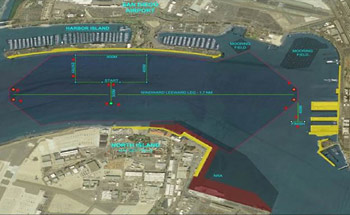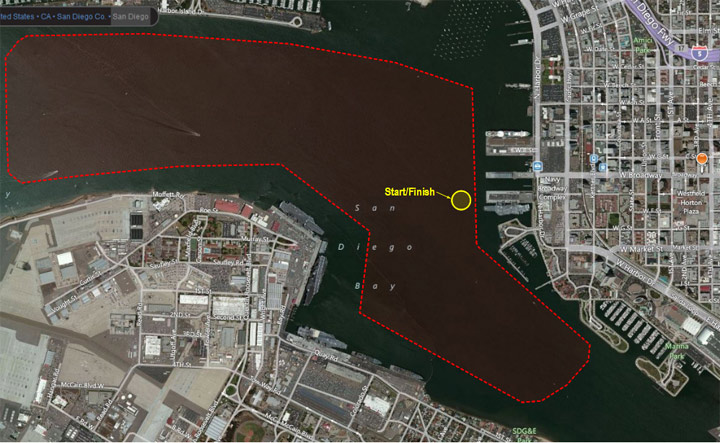What Might Have Been: San Diego's Bid to Host the 2017 America's Cup
Conversation with San Diego YC Commodore John Laun
January 15,
2015

San Diego saluting BMWOR's trimaran USA-17, next to replica of schooner
yacht America.
Photo: ©2009 Gilles
Martin-Raget/BMW Oracle Racing
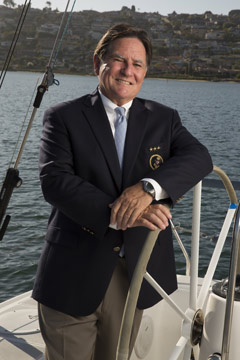 |
|
John Laun.
Image: ©Tim Mantoani/SDYC
|
|
Now that the dust has settled on the venue choice for the 35th
America’s Cup, CupInfo takes a look at San Diego’s runner up bid – what went
right, what went wrong and what might have been.
John Laun, President and CEO of Sailing Events Association San
Diego (SEA San Diego), was an integral part of San Diego’s consideration
process. Laun, the owner/driver of the locally raced J120 caper as
well as the recently-named Commodore of the San Diego Yacht Club, takes us
through the process from his perspective.
It all started with a phone call a little over a year ago.
“Malin Burnham got a call from Russell Coutts asking if San
Diego would like to be considered as a venue,” said Laun. “Russell had
been working with San Francisco and they had gotten a preliminary response from
the mayor. It wasn’t everything they had hoped for, so he started thinking
about alternatives.”
San Diego has a rich America's Cup history, having hosted
successful defenses in 1988 and 1992, as well as the dominating Kiwi victory in
1995. More recently in 2011 Laun and SEA San Diego coordinated an RC44
regatta and an America’s Cup World Series event, so the machinery to pursue
another America’s Cup was already in place. Coutts provided the San Diego
contingent with an idea of the infrastructure requirements both on and off the
water, and the San Diego team went to work.
Members of the task force included Laun; Chuck Nichols,
Chairman of SEA San Diego; Tim Kelley, Executive VP and marine engineering
expert; Sharon Cloward, President of the Port Tenants Association; Jeff Brown,
President of JK3 Yachts; and Troy Sears, owner of Next Level Sailing.
“Troy’s son Tom had just graduated from USC’s architecture
school, so he did the venue layout CAD work,” Laun said. “We had the bases
fitting the original spec, which was intended for the defender and four
challengers who would make it to the final venue. The schematic included
superyacht berths, the AC Village and a concert venue, all in the Embarcadero
area of downtown San Diego. We had room for bleachers, spectator areas,
interactive areas, hospitality, and VIP hospitality on the flight deck of the
USS Midway. It’s an amazing stadium; there would have been views of the
action on the whole course from all over the harbor.
“Added to the original spec was a long-term base for the
Oracle team to use for training in advance of the Cup. We then went to the
Port Commissioners, to let them know we had scoped out the required spec and to
find out if there was interest, and we got a very enthusiastic response.”
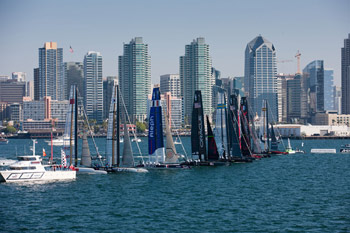 |
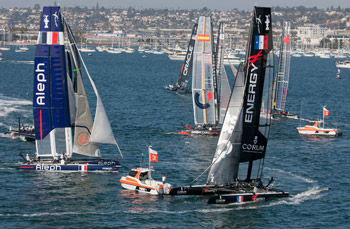 |
|
America's Cup World Series fleet racing in San Diego from
October, 2011.
Photos(2): ©2011 Gilles
Martin-Raget/ACEA
|
The RFI
SEA San Diego replied to Coutts, indicating that San Diego
could indeed meet the spec and that they were interested in continuing the
process. The America’s Cup Event Authority (ACEA) sent out Requests for
Information (RFI) to several cities (Laun heard 12 cities received the requests,
but only knows the identities of the four finalists). The RFI sought very
specific information about the venue, including the infrastructure and the
water-based requirements. The RFI also asked for details about the host
city candidates, such as hotels, the airport, all the transit operations,
restaurants and attractions, as well as specifics about cooperation with all the
entities involved in San Diego Bay: Coast Guard, Navy, Customs and Border
Protection, and FAA among others. For the SEA San Diego team, it was all
the same information and same players they’d coordinated in order to
successfully hold the ACWS event three years earlier.
“We knew that San Diego was being labeled a ‘light wind venue’
and I suppose next to San Francisco, we are,” Laun said. “But we had
historical weather data from a weather station on North Island indicating that
the breeze was very reliable, which is critical for TV broadcast schedules --
more than eight knots 91 percent of the time during the broadcast window.
Jeff Brown put a weather station on a boat in the middle of the race course for
two weeks so we had data that could be used to calibrate the years of weather
station data to actual course conditions. Julian di Biase from ACEA and
the Oracle weather team analyzed all that data. From our standpoint, we
had everything we needed to host a successful America’s Cup.
“The Port of San Diego responded to the RFI in March, after
analysis of the financial benefits (theirs and regionally) and also their costs
to provide the facilities (potential lost revenue), some minor improvements,
permitting, and services such as Harbor Police. Then, we all watched as
one by one, San Diego’s competitors were eliminated. As the summer
continued, first San Francisco, then Chicago were taken off the list of
potential venues, leaving San Diego and Bermuda to vie for the chance to host
AC35. The Port was then requested to take the next step to turn the
details of the RFI response commitments into the Host Venue Agreement language.”
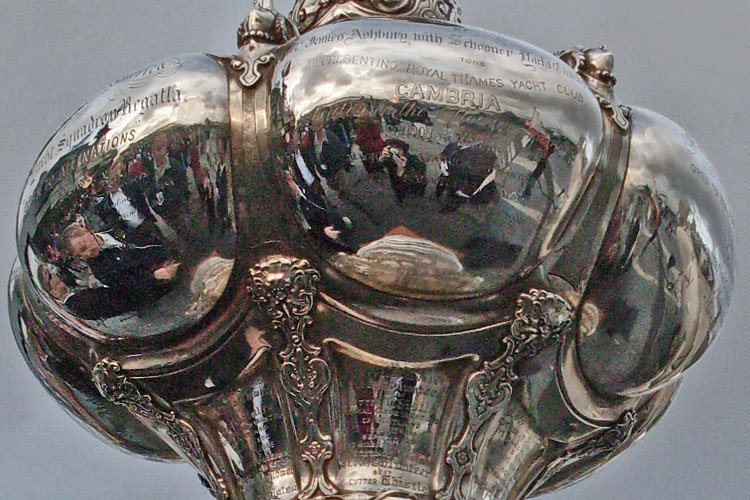 |
|
San Diego welcoming the America's Cup back
after BMW Oracle Racing's victory in 2010. Image: ©2010 Jim Swintal
|
The Host Venue Agreement
“The Port was the lead for the Host Venue Agreement drafting
with ACEA, soliciting support from the City of San Diego, the County and other
entities that would be involved in the infrastructure and services required.
The Port commissioners, representing the five cities that border San Diego Bay,
developed the negotiating positions on the key details remaining. The Port
desired to keep the negotiations confidential, so by California law, only the
negotiating parties (Port Commissioners and Port staff) could know the details.
Our team was briefed informally and we offered suggestions and opinions from
time to time, but we have not seen the actual documents or participated in the
Host Venue Agreement discussions with ACEA.
“Our team handled all the community and support issues,
garnering letters of support and promises of potential activities in support of
the Cup from agencies such as the San Diego Economic Development Corporation,
the Chamber of Commerce, the Tourism Authority, etc. San Diego Mayor Kevin
Faulconer was an early advocate, and we met personally with most of the City
Council members, [who] passed a unanimous resolution in support of the hosting
the Cup, as did the County Supervisors.”
Laun was pleased with the degree of enthusiasm from commercial
interests across San Diego and feels that sponsorship support would have come
from every sector of local business -- despite the inherent initial uncertainty
in trying to solicit sponsors for an event that might or might not happen.
“We received enthusiastic support from all over San Diego,
including from the San Diego Padres,” Laun said. “The Padres were prepared to
provide event management services, ticketing, cross promotion -- a whole family
of things. The Padres were more than willing to do as much, if not more,
than the Giants did during the last Cup and they were a delight to deal with.
“We reached out to local companies for corporate sponsorship,
providing introductions and facilitating discussions for ACEA, but the
responsibility for signing and closing the sponsorship deals was with the ACEA.
We were a party to almost all the communications but in the end, it would have
been their deals.
“ACEA was in final negotiations with what would have been a
Tier Two sponsor, had we gotten the Cup -- and that’s a big deal for San Diego,
since there aren’t that many corporate headquarters here. We lined up a
number of Tier Three and Four sponsors, some in-kind, some cash. All, of
course, contingent upon San Diego being selected as the venue.”
While several key ACEA and Oracle Team USA (OTUSA) members
were part of the selection process (including Julien di Biase, OTUSA’s
facilities and logistics manager; Steven Roberts on commercial interests; and
Sam Hollis on contracts), Russell Coutts remained part of the negotiations every
step of the way.
“Russell came out here three or four times and met with key
potential sponsors and met with the City and Port. When Russell came to
town, he generally had many meetings, political and commercial as well as with
the Port. People questioned whether we could fit the America’s Cup in the
harbor, but Russell Coutts and Jimmy Spithill seemed to think it would fit just
fine.”
 |
 |
Accepting the key to the city in
2010.
Image: ©2010 Jim Swintal
|
BMW Oracle team celebration
onboard USS Midway.
Photo:©2011 Gilles
Martin-Raget/BMW Oracle Racing
|
The Choice is Made
Laun admits to being somewhat shocked when word leaked out
that Bermuda had earned the nod as the AC35 venue.
“We now know that San Diego did not put up anything near the
kind of financial commitment that Bermuda did, but I think we met or came very
close to ACEA’s requirements. I do suspect that some parts of the Port’s
bid were contingent upon environmental permits. That kind of uncertainty
is not good -- and San Diego does have a history of litigating environmental
issues. I believe a major reason the Port did not express an interest in
an America’s Cup World Series event here in 2015 is because the permit work
might not be obtained that quickly.
“Some people said we were being used to get more concessions
from other venues, and others would come to us and say ‘they won’t go there;
you’re bidding against yourselves.’ Of course, it’s hard to know at the
time and we just worked to put forth the best offer we could. Personally,
I was quite surprised to lose to Bermuda. I thought it was much more
likely that we would lose it to some sort of last minute ‘Hail Mary’ from San
Francisco. But as far as I know -- and I really believe this to be the
case -- there really was not any conversation with San Francisco after the
middle of the year. I’ve heard it enough and, now that Bermuda has been
chosen, I believe it. I’m stunned, but I believe it.”
Bermuda vs San Diego
“A great deal has been made of the time zone and it works well
for TV in Europe, but it doesn’t work so well for New Zealand and it certainly
doesn’t work for Australia, though that’s moot now. It also doesn’t work
so well for potential teams from China or Japan. But for the teams from
Europe that are funded now, or likely to be funded, I think the time zone works
well. And, maybe there is broadcast money to be made or sponsors to be
lined up because of that.
“Russell has been quoted as saying that all the teams would
not fit in San Diego. We certainly could fit the original spec of five and
I think we could have fit one more. But who knows how many teams will
still be viable in 2017?
“The financial package that Bermuda is reported to have put
together is amazing, between venue fees, sponsor guarantees, infrastructure
improvements, services, etc. Their economic benefit numbers were
comparable to the final numbers in San Francisco and very comparable to the
studies we did here.
“You saw a great deal of enthusiasm from Bermuda when the Cup
was there a few weeks ago – I don’t know if it would have been quite like that
in San Diego, but on the flip side, if you want to have an event with great
numbers of spectators, San Diego is a much better venue to attract hundreds of
thousands of spectators, for racing, concerts, etc. I think Bermuda will
be much more of a broadcast and high-end hospitality venue. I think the
commercial considerations are extremely important now.”
In the end, Laun is gracious as always despite his
disappointment -- and looks forward to cheering their hometown heroes.
“I’m sure Bermuda will realize a long-lasting benefit from the
hosting America’s Cup and I’m sure the sailing will be beautiful. It will
be great television. I wish the Oracle team well; I hope they have a great
event and a successful defense. We’re rooting for our local talent, SDYC
members Jimmy Spithill and Andrew Campbell.”
-- By Diane Swintal for CupInfo.com/©2015
CupInfo.com

Photo:©2011 Guilain Grenier/Oracle Team USA
Additional Links and Info:
Bermuda Venue Announcement (Dec 2, 2014)







